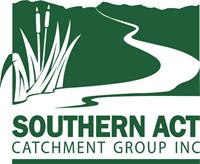The view from Coordinator’s desk

Here’s the belated update for last Spring. As usual it will be a bit bug-centric. October was our last month with below average rainfall and September was extremely dry. The reduced runoff since autumn was appreciated by critters in most of our waterways. Almost all the bug survey results in flowing waterways showed improvements on autumn when it was still exceptionally wet. Water quality was by and large excellent around the natural waterways. Pollutants such as phosphorus jumped up in some urban areas when the rain returned. This is not unexpected.
I also tried to make good on my threat to post as many embarrassing photos as possible, but this proved impossible as I have the best looking Waterwatchers in the country.
WW Teams update
Some good people left us this season. First was Rojee who had kept an eye on the northern end of Lake Tuggeranong for many months. After moving from Nepal a couple of years ago Rojee won an engineering job in Kalgoorlie using Waterwatch as a key reference. Not wanting to overshare, I only mention this to highlight a side benefit Waterwatch volunteering has had in some members lives.
Next to go was Alannah who, over a number of years, has monitored the Naas and Gudgenby rivers as well as Lake Tuggeranong and Tuggeranong Creek. Alannah finally got too busy with work and study. These two quite achievers will be sorely missed.
Around the Rivers and Creeks

Our more remote rivers, namely Cotter, Orroral, Naas and Gudgenby all had beautifully clear water all spring. So did our various creeks such Tuggeranong Ck and Gibraltar Ck. Paddy’s river also remained unusually clear except after heavy rain in October when a lot of mud was recorded by ranger James at Flint’s Crossing. The Murrumbidgee was generally murkier except at the Sandwash and Uriarra. The waterbug surveys all returned better diversity and sensitivity scores than last autumn with the one exception being Gibraltar creek where the diversity actually fell. The Murrumbidgee river had stonefly nymphs at 3 of the 4 sites checked. This not a common occurrence and is a sign of good river health.
Around the Lakes and ponds

Our various puddles had very individual responses to spring. Isabella Pond and the drains that lead into it had the highest nutrient loads, especially after rain. Cooleman Ridge’s dam’s had high levels of phosphorus and the old dam was covered in floating Azolla wihich had been there since March. Lake Tuggeranong had lots of frisky carp at the southern end by November (an few dead ones near the town center), but the water quality wasn’t bad. Point Hut had pretty murky water especially in the south along with cyanobacteria in October. Stranger Pond’s inlet got pretty gross but the water was much cleaner by the time it got to the dam. Don’t be fooled by the smiles,the bug surveys showed less diversity this season as species found in autumn went awol by spring.
Around Tidbinbilla and Namadgi

Our national park and local nature reserve continued to show signs of slow recovery from the ravages for 2019/20. Water quality was found to be very good but there was still a residual amount of phosphorus hanging around the upland bogs of Namadgi NP and in Tidbinbilla’s river and wetlands. A large tree was heard crashing to the ground in the hill (Yankee Hat) above Bogong Creek as we did the bug survey in October. A solemn reminder of the risks posed in a fire affected forest for years after. The waterbugs showed a bounce back in the populations of key sensitive species. Lots of stonefly nymphs and hundreds of mayfly nymphs and caddisfly larva were caught (and, of course, carefully returned) at all sites.
Around the schools and youth groups
This spring the schools and groups enjoying bug hunting and other waterwatch activities included; Weston Joey Scouts, Lake Tuggeranong College and Lyons Primary School (with Icon Water’s Kate Rhook). School holiday programs included the usual ‘World of Waterbugs’ hosted by the Visitor Assist Program volunteers at Tidbinbilla and giving Jed (MCG WW Coordinator) a hand at the ‘Living on the Edge’ waterways day at the National Museum. Yolandi (GCG WW Coordinator) and I also helped Jed with the year 4 cohort at Ainslie Primary School.

A huge thank you to all. Keep up the great work!
Martin


